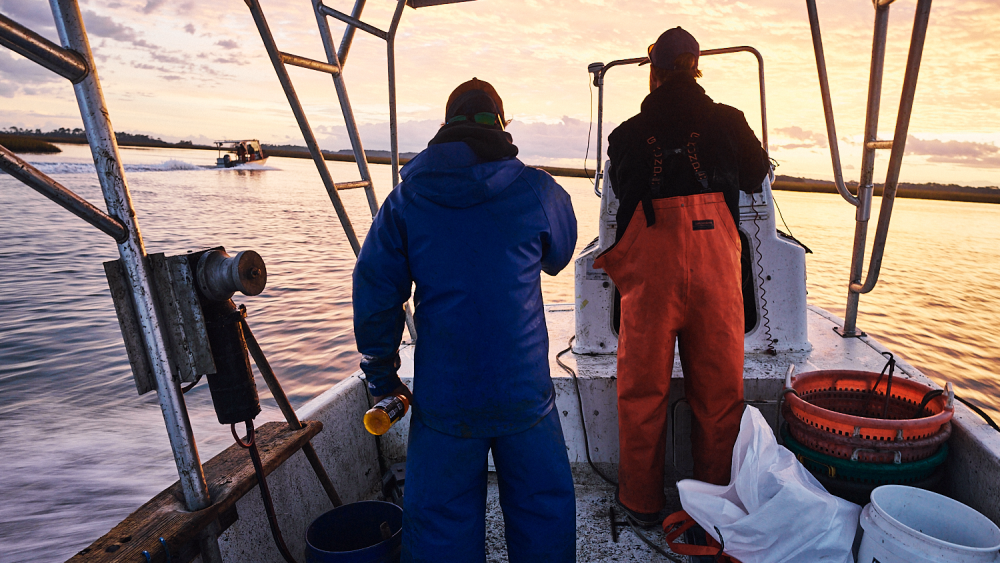If there’s an r in the month’s spelling, it’s a good time to eat them, and if there’s a y in the day’s spelling, it’s a good time to talk about them. We caught up with Captain Thomas Bierce, owner of Charleston Oyster Farm, who gave us the scoop on oysters.
Keep reading to learn about the role oysters play in the ecosystem + preservation, harvesting, and what impacts an oyster’s flavor.
How do oysters play a role in a healthy ecosystem?
Oysters play an enormous role in the health of the ecosystem because they are the literal foundation of the habitat where most of the benthic (bottom-dwelling) organisms live. Species-rich oyster reefs serve as buffets for some animals and shelter for others. A healthy oyster population will keep the waters they occupy cleaner by filtering the water as the tides ebb and flow past the oyster’s gills.
How does farming oysters play a role in preservation?
Oysters grown on farms are mostly hatchery-raised oysters meaning they would not otherwise exist. Farm-raised oysters take some of the harvesting pressure off of the wild oyster reefs due to increased demand. Shells from these operations ultimately get recycled back into the environment and used for wild oyster larvae to settle onto and crest a brand-new reef. Oyster farms have also been shown to have higher species abundance and diversity around them.
Can you taste the difference between farmed vs. wild oysters?
The main difference between wild and farm-raised oysters is their proximity to the bottom. Different growing environments provide different blends of phytoplankton and nutrients they feed on, giving them subtle differences. One thing that remains the same is the briny flavor. Our site is very close to the Stono River Inlet, which provides all the oysters in this particular area with abundant salt.
Can you explain your open cage systems?
The floating cages are designed to hold the oysters just under the surface all the time by rising and falling with the tides. Surface water holds more phytoplankton and nutrients than deeper depths because of the higher levels of sunlight which makes them grow faster. Never having the oyster stop feeding at low tide like their wild counterparts helps them grow faster as well. Cages also allow farmers to flip the cages up for an extended period during the summer to control any wild oysters or barnacles from landing on the singles. Without this mechanism, all the singles would turn into clusters in a matter of weeks. The biggest benefit to using floating cages is they give us the ability to harvest oysters year-round by allowing us to keep them sub-tidal and buffered from the daytime temperatures. Everyone thinks it is the water temperature in the summertime that makes oysters unsafe to eat but it is the air temperature. At low tide, wild oysters are exposed to the winds and rays which can bake them causing increased bacteria levels, but oysters that have been submerged for at least two consecutive weeks are safe to eat.
What is the process of harvesting oysters?
- To collect wild oysters involves getting off the boat at low tide and walking through deep pluff mud to access the reefs. Clusters that have at least one 3-inch oyster can be harvested. Anything too small is “culled” in place so that it may keep growing. The most sustainable way to do this is to plant while you pick. Moving oysters around and expanding the reef’s footprint can make a huge difference the next year.
- Harvesting farm-raised oysters is done entirely from inside the boat. Once you’re alongside the cages a crane hauls up the cages and oysters which are pre-counted into 100-count bags (each cage holds 6 bags). Harvest information like time of harvest and location are recorded on a harvest tag that will be later transferred onto each sale tag once the layers have been processed and loaded into the sale bags. Harvesting in the summer requires a different permit and there are strict time and temperature requirements to ensure the safety of the product. Summer regulations require harvesters to land their product before 10 a.m. and have the temperature of the oysters down below 50 degrees within two hours or brought back covered in ice for a landing after 10 a.m.
What gives different types of oysters different flavor profiles?
Oysters take on the flavor of the water they are grown in similarly to how grapes take on the flavor of the earth they are grown in. Winemakers use the term “terroir” but we use the term “merroir” for oysters. Things that influence flavor are the tide, season, geology, available food, location, and even the weather.
What’s your favorite way to eat oysters?
My favorite way to eat an oyster is straight out of the water raw which is what guests on our oyster farm tours get to experience!
More about Charleston Oyster Farm
Apart from providing delicious oysters, Charleston Oyster Farm aims to promote healthy ecosystems, environmental awareness, and local mariculture. Order oysters, book a farm tour, and learn more about the COF.


















